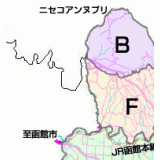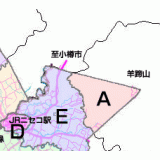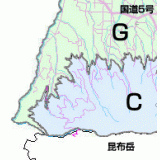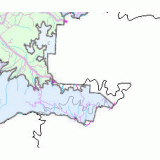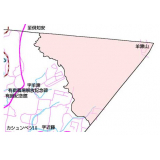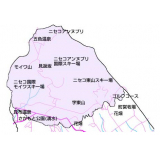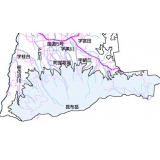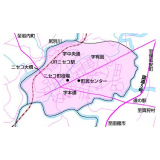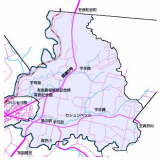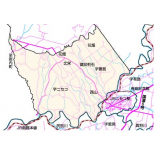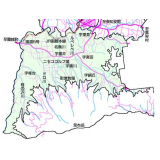ニセコの自然環境
ニセコの自然環境の特徴
ニセコには、全国の一級河川清流ランキングで1位となった(平成12年度)尻別川をはじめ、大小たくさんの清流が流れています。また、ニセコ山系や羊蹄山から湧き出る澄んだ水にも恵まれています。そして、水を守る森が広がり、そこには多くの動植物が生きています。
環境ワークショップ*など実際にニセコを歩く体験を通じ、多くの参加者が河川や水源を中心とした「水」を基盤として私たちが生活していることを再認識しました。農業、レジャー、生活など、さまざまな人間活動の基盤にこの「水」をかかせないのがニセコです。この「水環境」保全を基盤として自然環境を守り育てること、これがニセコにおける人と自然の共生テーマです。
注:「まちを知る調査」(地元学の手法により身の回りを調査)を進めています。今までに、町内の農家、商店、川、水源等を調査しています。
環境ワークショップ*など実際にニセコを歩く体験を通じ、多くの参加者が河川や水源を中心とした「水」を基盤として私たちが生活していることを再認識しました。農業、レジャー、生活など、さまざまな人間活動の基盤にこの「水」をかかせないのがニセコです。この「水環境」保全を基盤として自然環境を守り育てること、これがニセコにおける人と自然の共生テーマです。
注:「まちを知る調査」(地元学の手法により身の回りを調査)を進めています。今までに、町内の農家、商店、川、水源等を調査しています。
動植物リスト
動物
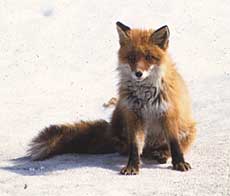
哺乳類
| 目・科 | 名 | 生息確認済み | 備考 |
| 食中目 トガリネズミ | エゾトガリネズミ | ||
| オオアシトガリネズミ | |||
| 翼手目 ヒナコウモリ | ホオヒゲコウモリ | R | |
| ヒナコウモリ | R | ||
| 齧歯目 ネズミ | エゾヤチネズミ | ○ | |
| エゾアカネズミ | |||
| クマネズミ | 移入種 | ||
| ドブネズミ | 移入種 | ||
| 齧歯目 リス | エゾシマリス | ○ | |
| エゾリス | ○ | ||
| エゾモモンガ | ○ | ||
| 兎目 ウサギ | エゾユキウサギ | ○ | |
| ヨーロッパユキウサギ | 外来種 | ||
| 食肉目 イタチ | ニホンイイズナ | ||
| エゾオコジョ(エゾイタチ) | ○ | Vu | |
| エゾクロテン | ○ | ||
| ホンドテン | 移入種 | ||
| ホンドイタチ | 移入種 | ||
| ミンク | 外来種 | ||
| 食肉目 イヌ | キタキツネ | ○ | |
| エゾタヌキ | ○ | ||
| 食肉目 クマ | エゾヒグマ |
両生類
| 目・科 | 名 | 生息確認済み | 備考 |
| 有尾目 サンショウウオ | エゾサンショウウオ | ○ | |
| キタサンショウウオ | |||
| 無尾目 アカガエル | エゾアカガエル | ○ | |
| ウシガエル | |||
| ツチガエル | |||
| 無尾目 ヒキガエル | エゾヒキガエル | ||
| 無尾目 アマガエル | アマガエル |
爬虫類
| 目・科 | 名 | 生息確認済み | 備考 |
| 有鱗目 カナヘビ | ニホンカナヘビ | ||
| コモチカヘビ | Vu | ||
| 有鱗目 スキンク | ニホントカゲ | ||
| 有鱗目 スナヘビ | シマヘビ | ○ | |
| ジムグリ | |||
| アオダイショウ | ○ | ||
| 有鱗目 マムシ | ニホンマムシ |
- Vu 絶滅危急種 Vulnerable
- R 希少種 Rare
魚類
魚の生息にも、地形や地域特性の影響が見られます。 畑や水田が多い昆布岳周辺を流れる真狩川やルベシベ川には、多くの魚種が生息しています。また、河岸段丘が多いニセコ町域の尻別川では、魚種に他地区と異なる特徴が見られます。尻別川の王子発電所ダムには魚道が設置されているので、サケやサクラマスは、このダムの上流にも遡上しています。
畑や水田が少ないアンヌプリ周辺は、きれいな細かい沢や伏流水が多く、イワナなどこれを好む魚種が生息しています。反対に、アンベツ川には温泉が流入しているので、その下流では魚は見かけません。
畑や水田が少ないアンヌプリ周辺は、きれいな細かい沢や伏流水が多く、イワナなどこれを好む魚種が生息しています。反対に、アンベツ川には温泉が流入しているので、その下流では魚は見かけません。
| 名 | 生息確認済み | 備考 |
| イトウ | ○ | Cr |
| イワナ | ○ | |
| ニジマス | ○ | |
| アメマス | ○ | |
| オショロコマ | ○ | R |
| ヤマメ | ○ | 4、5月禁漁 |
| ウグイ | ○ | |
| カジカ | ○ | |
| ヤツメウナギ | ○ | |
| 水生物 | ||
| ニホンザリガニ | ||
| ゲンゴロウ | ||
| オオミズスマシ | ||
| ミズカマキリ | ||
- Cr 絶滅危機種 Critically Endangered
- R 希少種 Rare
昆虫類
植生の垂直分布に沿って、昆虫の分布に明らかな相違が見られます。例えば、シラカバからダケカンバに変わると、昆虫も変わります。これは、昆虫が食樹に大きく影響を受けているのです。また、3月でも山に残っている沢沿いの雪渓で、セッケイカワゲラの歩行が多く見られるのも、特徴のひとつです。
野鳥の生息分布の特性に見合って、昆虫の分布も異なっています。例えば、サトキマダラよりヤマキマダラの方が多いなど、山林の虫は多く、モンシロチョウ、モンキチョウのような草原の虫は少ないのです。
河川流域の地形特性も、昆虫の生息に影響を与えています。例えば、ニセコ町内の尻別川流域は、蘭越町などと異なり河岸段丘が多く河原が少ないので、川縁はすぐ林となるため、川のすぐ近くに山林の虫がいる、等といった特徴が見られます。
また、チョウや甲虫類が多いことや、地方変異が多いのも、ニセコの特徴です。
野鳥の生息分布の特性に見合って、昆虫の分布も異なっています。例えば、サトキマダラよりヤマキマダラの方が多いなど、山林の虫は多く、モンシロチョウ、モンキチョウのような草原の虫は少ないのです。
河川流域の地形特性も、昆虫の生息に影響を与えています。例えば、ニセコ町内の尻別川流域は、蘭越町などと異なり河岸段丘が多く河原が少ないので、川縁はすぐ林となるため、川のすぐ近くに山林の虫がいる、等といった特徴が見られます。
また、チョウや甲虫類が多いことや、地方変異が多いのも、ニセコの特徴です。
| 目 | 名 |
| 双翅目 | アカウシアブ |
| ヤマトアブ | |
| ゴマフアブ | |
| イエバエ | |
| 膜翅目 | スズメバチ |
| クロスズメバチ | |
| キイロスズメバチ | |
| ジガバチ | |
| コマルハナバチ | |
| クロオオアリ | |
| アカヤマアリ | |
| ウスバカゲロウ | |
| ムラサキトビゲラ | |
| 脈翅目 | オオハサミムシ |
| 甲虫目 | ヒメクロオサムシ |
| エゾマイマイカブリ | |
| ルリハムシ | |
| ミヤマクワガタ | |
| ノコギリクワガタ | |
| センチコガネ | |
| ノコギリカミキリ | |
| キマワリ | |
| ヒメツチハンミョウ | |
| オオヒラタシデムシ | |
| アオゴミムシ | |
| セアカヒラタゴミムシ | |
| ナナホシテントウ | |
| オオゾウムシ | |
| 鱗翅目 | コチャバネセセリ |
| キアゲハ | |
| ミヤマカラスアゲハ | |
| モンシロチョウ | |
| クジャクチョウ | |
| ヒトリガ | |
| ウラギンスジヒョウモン | |
| スジグロシロチョウ | |
| サトキマダラヒカゲ | |
| ジャノメチョウ | |
| ルリタテハ | |
| キベリタテハ | |
| イチモンジチョウ | |
| ミスジチョウ | |
| ヒメアカタテハ | |
| エゾシロチョウ | |
| エゾシジグロシロチョウ |
鳥類
ニセコの野鳥は、地形や土地利用などの地域特性に見合った生息状況を示しています。
その最も大きな特徴は、林の野鳥が多いことです。特に、アオジ、コルリをとても多く見かけます。
反対に、草原や湿地、湖などに生息する野鳥が少ないことや、スズメやツバメなど街の中に生息する野鳥が案外少ないことも、特徴となっています。 川の鳥もある程度いますが、カモメなどの海鳥も少し見かけます。これは、尻別川という大河がもたらした結果でしょう。
その最も大きな特徴は、林の野鳥が多いことです。特に、アオジ、コルリをとても多く見かけます。
反対に、草原や湿地、湖などに生息する野鳥が少ないことや、スズメやツバメなど街の中に生息する野鳥が案外少ないことも、特徴となっています。 川の鳥もある程度いますが、カモメなどの海鳥も少し見かけます。これは、尻別川という大河がもたらした結果でしょう。
| 科 | 名 | 生息確認済み | 備考 |
| サギ | アオサギ | ○ | |
| ガンカモ | コクガン | R | |
| マガン | R | ||
| ヒシクイ | R | ||
| オオハクチョウ | |||
| コハクチョウ | |||
| オシドリ | ○ | R | |
| マガモ | ○ | ||
| カルガモ | |||
| コガモ | ○ | ||
| ヨシガモ | |||
| オオヨシガモ | |||
| ヒドリガモ | |||
| オナガガモ | ○ | ||
| ハシビロガモ | |||
| ホシハジロ | |||
| キンクロハジロ | ○ | ||
| ホオジロガモ | ○ | ||
| ミコアイサ | Vu | ||
| カワアイサ | ○ | ||
| ワシ・タカ | トビ | ○ | |
| オジロワシ | En | ||
| クマタカ | ○ | En | |
| オオタカ | ○ | Vu | |
| ハイタカ | ○ | Vu | |
| ハチクマ | ○ | ||
| ノリス | ○ | ||
| チュウヒ | Vu | ||
| ハヤブサ | ハヤブサ | Vu | |
| チゴハヤブサ | |||
| チョウゲンボウ | |||
| ライチョウ | エゾライチョウ | R | |
| キジ | ウズラ | R | |
| コウライキジ | |||
| クイナ | ヒクイナ | R | |
| バン | |||
| オオバン | |||
| チドリ | コチドリ | ||
| シロチドリ | |||
| メダイチドリ |
- En 絶滅危惧種 Endangered
- Vu 絶滅危急種 Vulnerable
- R 希少種 Rare
植物
しだ植物
| 科 | 名 | 備考 |
| ヒカゲノカズラ | コスギラン | |
| タカネスギカズラ | ||
| トウゲシバ | ホソバトウゲシバ | |
| ヒカゲノカズラ | ||
| ヒメスギラン | ||
| マンネンスギ | ||
| トクサ | スギナ | |
| トクサ | ||
| ミズドクサ | ||
| ハナヤスリ | エゾフユノハナワラビ | |
| ナガボノナツノハナワラビ | ||
| ナツノハナワラビ | ||
| ゼンマイ | ゼンマイ | |
| ヤマドリゼンマイ | ||
| コケシノブ | コケシノブ | |
| オシダ | イヌガンソク | |
| イヌシダ | ||
| イワイヌワラビ | ||
| イワガネゼンマイ | ||
| ウサギシダ | ||
| エゾメシダ | ||
| オオバショリマ | ||
| オシダ | ||
| クサソテツ | ||
| クジャクシダ | ||
| コウヤワラビ | ||
| ジュウモンジシダ | ||
| シラネワラビ | ||
| ナライシダ | ||
| フクロシダ | ||
| ヘビノネコザ | ||
| ホソイノデ | ||
| ミゾシダ | ||
| ミヤマシケシダ | ハクモウイノデ | |
| ミヤマベニシダ | ||
| ミヤマメシダ | ||
| ミヤマワラビ | ||
| ヤマイヌワラビ | ||
| ヤマソテツ | ||
| リョウメンシダ | ||
| ワラビ | ||
| チャセンシダ | コタニワタリ | |
| トラノオシダ | ||
| シシガシラ | シシガシラ |
木本
| 科 | 名 | 備考 |
| イチョウ | イチョウ | 外来種 |
| イチイ | イチイ | 植栽を含む |
| イヌガヤ | ハイイヌガヤ | |
| マツ | アカマツ | 移入種 |
| エゾマツ | 植栽を含む | |
| カラマツ | 移入種 | |
| ドイツトウヒ | 外来種 | |
| トドマツ | 植栽を含む | |
| ハイマツ | ||
| スギ | スギ | 移入種 |
| メタセコイア | 外来種 | |
| ヤナギ | イヌコリヤナギ | |
| エゾノカワヤナギ | ||
| エゾノバッコヤナギ | ||
| オノエヤナギ | ナガバヤナギ | |
| キツネヤナギ | ||
| ギンドロ | 外来種 | |
| ドロノキ | ||
| マルバヤナギ | エゾノタカネヤナギ | |
| ミヤマヤナギ | ミネヤナギ | |
| エゾノキヌヤナギ | ||
| ウンリュウヤナギ | 外来種 | |
| タチヤナギ | ||
| クルミ | オニグルミ | |
| カバノキ | アサダ | |
| ウダイカンバ | ||
| ケヤマハンノキ | ||
| サワシバ | ||
| シラカンバ | ||
| ダケカンバ | ||
| ツノハシバミ | ||
| ハンノキ | ||
| ヒメヤシャブシ | ||
| ミヤマハンノキ | ||
| ブナ | カシワ | |
| クリ | 移入種 | |
| ミズナラ |
環境マップ
このページの情報に関するお問い合わせ先
- 企画環境課環境モデル都市推進係
- TEL:0136-56-8837
- FAX:0136-44-3500
